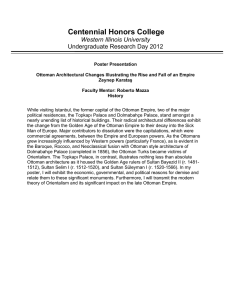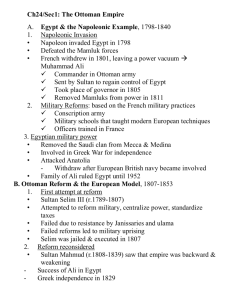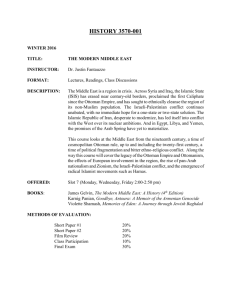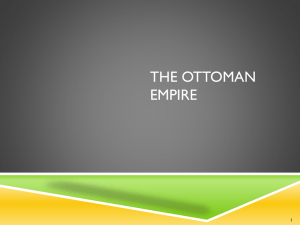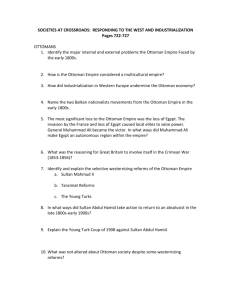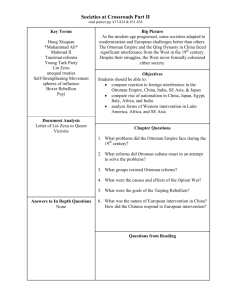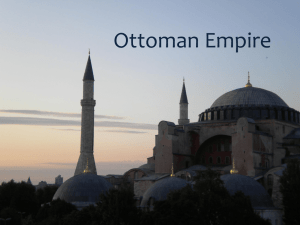(-2po§) 'V^ 2.18 The Transformation of the Eighteenth
advertisement
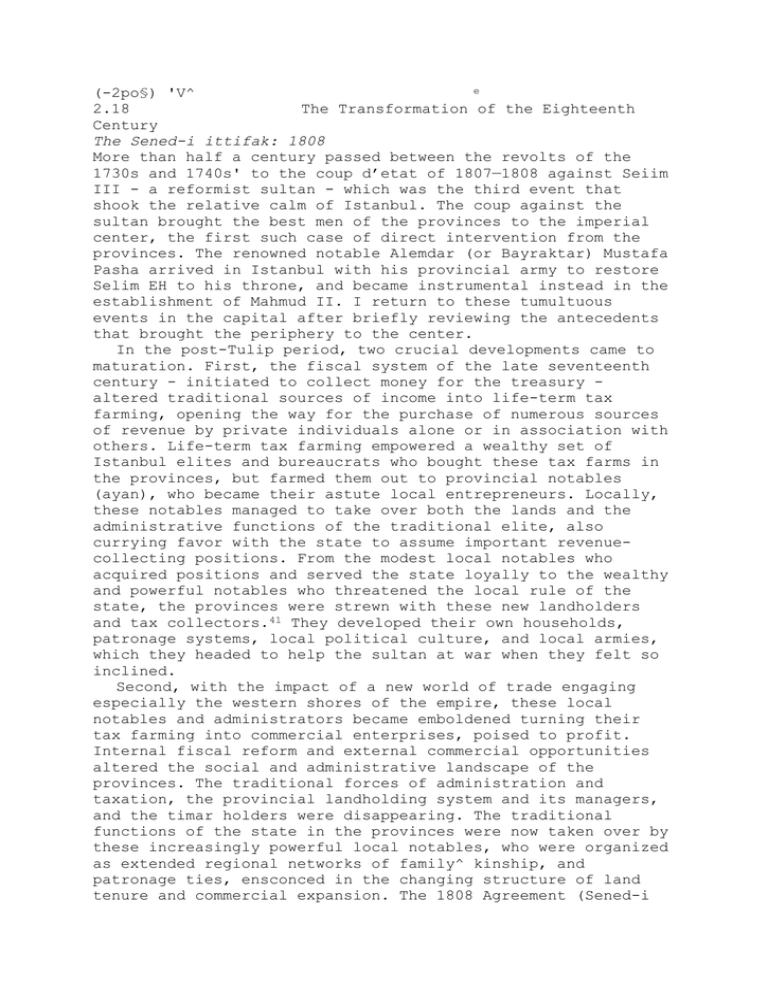
e
(-2po§) 'V^
2.18
The Transformation of the Eighteenth
Century
The Sened-i ittifak: 1808
More than half a century passed between the revolts of the
1730s and 1740s' to the coup d’etat of 1807—1808 against Seiim
III - a reformist sultan - which was the third event that
shook the relative calm of Istanbul. The coup against the
sultan brought the best men of the provinces to the imperial
center, the first such case of direct intervention from the
provinces. The renowned notable Alemdar (or Bayraktar) Mustafa
Pasha arrived in Istanbul with his provincial army to restore
Selim EH to his throne, and became instrumental instead in the
establishment of Mahmud II. I return to these tumultuous
events in the capital after briefly reviewing the antecedents
that brought the periphery to the center.
In the post-Tulip period, two crucial developments came to
maturation. First, the fiscal system of the late seventeenth
century - initiated to collect money for the treasury altered traditional sources of income into life-term tax
farming, opening the way for the purchase of numerous sources
of revenue by private individuals alone or in association with
others. Life-term tax farming empowered a wealthy set of
Istanbul elites and bureaucrats who bought these tax farms in
the provinces, but farmed them out to provincial notables
(ayan), who became their astute local entrepreneurs. Locally,
these notables managed to take over both the lands and the
administrative functions of the traditional elite, also
currying favor with the state to assume important revenuecollecting positions. From the modest local notables who
acquired positions and served the state loyally to the wealthy
and powerful notables who threatened the local rule of the
state, the provinces were strewn with these new landholders
and tax collectors.41 They developed their own households,
patronage systems, local political culture, and local armies,
which they headed to help the sultan at war when they felt so
inclined.
Second, with the impact of a new world of trade engaging
especially the western shores of the empire, these local
notables and administrators became emboldened turning their
tax farming into commercial enterprises, poised to profit.
Internal fiscal reform and external commercial opportunities
altered the social and administrative landscape of the
provinces. The traditional forces of administration and
taxation, the provincial landholding system and its managers,
and the timar holders were disappearing. The traditional
functions of the state in the provinces were now taken over by
these increasingly powerful local notables, who were organized
as extended regional networks of family^ kinship, and
patronage ties, ensconced in the changing structure of land
tenure and commercial expansion. The 1808 Agreement (Sened-i
Ittifak) was the fin- de-siecle episode of the most powerful
among these men arriving in Istanbul to sign a political
document of state—notable truce and cooperation, following
their comrade from Rumelia, Bayraktar Mustafa Pasha.
At the center, Selim HI (1789-1807) had come to power at a
moment when the peripheries of the empire, both the near
periphery of the Balkans and the
4i Chapter 7 is devoted to an analysts of these state-society
processes.
2.1<j
An Eventful Eighteenth Century: Empowering the Political
farther Arab provinces, were feeling the tension between the
administration of the state and that of the local notables.
Rumblings of regional rebejionsjox autonomy emerged. In the
Balkans, the notables were competing for territory and
influence, often bringing the state into their local
struggles. Local rule by the agents of the center was
increasingly varied: weakening in certain areas while steady
and strong in others. For example, in the Serbian provinces,
the janissaries ran amok, but in the Bosnian provinces, law
and order prevailed due to good central-local administration
43 Yet, within this widespread variation of rule, movements
for autonomy such as that of the Serbs and the Greeks emerged.
In other regions, the near separation of Egypt, Syria, and
Iraq became of vital importance. It is in this- atmosphere
that Selim m commenced a series of reforms, the most important
of which was organized around the military. Selim m worked on
the reorganization of a new military in comparative secrecy
with the knowledge of a few reformer administrators; this
indicated that they were worried about the potential reaction
of the conservative Janissary forces and the ulema. For both
groups, such reforms represented threats to the traditional
order. Furthermore, that Selim was able to replenish his new
army with so diers and resources from among the provincial
armies also demonstrates that there were among the powerful
notables those who supported the new
young sultan in his endeavor to reform the more traditional
and reactionary forces at the center.44
A delicate and precarious balance between opponents and
supporters of SelimJs regime ensued as enemies of reform
multiplied in the provinces and in Istanbul. The Ottomans had
forever promoted power struggles on the periphery under the
belief that local and regional struggles for control between
different powerful notables was healthy and would deflect
opposition to the state. At the same time, they also used
armies of notables for the protection of the provinces and as
another reserve of military recruits during war. The
unintended consequence of such policies was that when a
notable accumulated local power and military might and decided
to turn against the state, he could cause significant damage
to the empure. Complicating Selim’s reform initiatives further
was the Russian movement into the Danubian principalities in
1806, the culmination of Russian interference in the affairs
of the Christian population of the Balkans, where they
fomented discontent and also created alliances with the Muslim
magnates of the periphery, especially in Egypt and northern
Anatolia.
In the capital, the supporters and the enemies of reform
battled among themselves until a coup led by the Janissaries
supported by the ulema gave the upper hand to the enemies of
reform. The coup was achieved on 2.5 May
44 r ^ ^icl<olc’ °ttorna'n Military Administration in EighteenthCentury Bosnia.
smail Hakki UmnCarsiii,Me$hur Rumeli Ayanlanndan Tirsinikli
Ismail, Yihk Oglu Suleyman
OlcUndN^biil: M^Matbaaa, i94z); Stanford J. Shaw, Between
Old and The Ottoman Empire under Sultan Seltm III, j789-i8o7
(Cambridge MA2.2,0
The Transformation of the Eighteenth Century
1807, when the reformer Raif Ivlahmud Pasha went to the
headquarters of the old yamak troops to pay their salaries and
to urge them to join the new army created by Selim III and his
men. Instead, the soldiers savagely killed the pasha. The
conservative forces fighting against change were at the
forefront of the coup; the Janissaries were afraid that the
new army, the Nizam-i Cedid, was going to put them out of
business; the ulema, meanwhile, steadfastly believed in the
evils of European influence in reform. By z8 May, various
contingents of the Istanbul military forces were having Ka
spirited debate over the legality of their actions,” before
all agreeing to join the rebellion at the Janissary barracks.45
Many reformers were executed, the reforms abolished, and,
finally, only after the tensions and the hazards of keeping
Selim HI as sultan mounted, he was dethroned to make way for
Mustafa IV on 2,9 May 1807.
This rebellion and treachery of the Janissaries launched a
coordinated response from the provinces, an alliance of the
ayan of Rumelia and Anatolia marching in unison under the
leadership of Bayraktar Mustafa Pasha, the most powerful
notable of Ottoman Europe. The political divisions in
Istanbul, the coup against Selim HI, the ruin in the Balkans,
and the increasing threat of the Russians came together to
propel responsible notables into action. In the chaos of the
palace and the confrontation between the new sultan and the
leader of the provinces, Selim HI was assassinated, thus
depriving the counter-coup forces of their most important
asset. The provincial leaders reacted quickly to install
instead Mahmud 31 (1808-1839) to the throne, removing Mustafa
for his younger cousin. Bayraktar Mustafa Pasha became the
grand vizier of the new sultan and proceeded once again to
gather reformers around him. From July to November 1808,
Bayraktar remained the dominant force in the empire. Soon
after becoming grand vizier, he appealed to his provincial
comrades to come to the capital for a special session
(me§veret-i amme) to discuss the affairs of the state. That he
invited his former colleagues to this assembly is interesting
in itself because it demonstrates the realization by a man of
the provinces of the need to coopt the provinces into a
project of the center. From this extraordinary meeting emerged
the document entitled “Sened-i Ittifak,” a political agreement
between state and provincial magnates.
The Sened-i Ittifak (literally, a deed of alliance or a
concord) was the first of its kind in political deal making in
the Ottoman Empire. The Sened was the political culmination of
the provincial march on Istanbul, yet was negotiated within
the context of strong state and societal actors. Those
historians who have emphasized the power of the ayan to the
detriment of the state have a tendency to see the end point of
this century — the takeover by Bayraktar Mustafa Pasha and the
1808 Sened-i Ittifak - as catastrophic for state affairs. They
see these events as heralding a serious loss of state power,
and especially for those historians interested in nationalism,
this historical moment signals a green light for
local/regional movements of self-determination. Others argue
45 Shaw, Between Old and New, 380.
An Eventful Eighteenth Century: Empowering the Political
2.2.X
for the relative insignificance of the event/6 The Sened-i
Ittifak represented a pact signed between the state and the
ayan with respect to their mutual responsibilities. In fact,
careful study of the documents related to the pact provides us
with an alternative explanation of centralization, espoused
especially by one Turkish scholar, I. H. Uzun^ar§ili, who
claims that the Grand Vizier Bayraktar Mustafa Pasha strove to
centralize the empire. I agree that reassembling these
important nodes of local power under state supervision would
certainly be a goal of centralization.
Centralization was necessary to reassert control over
European provinces. Prior to the reign of Selim HI, especially
the European parts of the empire had plunged into anarchy. In
the 1790s, the infamous notable Pasvanoglu rebelled against
the Ottoman state and its military reforms; many ayan operated
rebellious armies and with the increasing presence of bandits,
Macedonia and Thrace had fallen into complete disarray.47
Centralization was also necessary to pull in as many local
power holders as possible, reaffirming their role as agents of
the state. Among them, those who opposed the reforms of the
state perceived the efforts at centralization and the creation
of alternative armies as a direct threat to their well—
established provincial rights and privileges. Certainly the
relationship between the state and the ayan of Vidin,
Pasvanoglu, suggests that the animosity was the result of the
state’s attempt to forge alternative sources of regional power
in the provinces. Others however, in Rumelia and many in
Anatolia had forged alliances with the state and remained
loyal. Among those in Rumelia, Tirsiniklioglu promoted Selim
El’s reforms, and Bayraktar Mustafa Pasha - despite some early
hesitation, especially during the Russian
4
Itzkowitz, for example, delineates the eighteenth
century with two events; the 1703
Edime rebellion and the 1808 Sened-i Ittifak. He interprets
the latter as one more deadly nail in the Ottoman state’s
coffin, whereby a weak state made an agreement with strong
feudal interests. Furthermore, in his view, this agreement is
the first time old Islamic traditions of government and
society were forever altered. See Norman Itzkowitz, “Men and
Ideas in the Eighteenth Century Ottoman Empire,” in Studies in
Eighteenth-Century Islamic History, ed. Thomas Naff and Roger
Owen {Caxbondale: Southern Illinois University Press, 1977)
15-2.6 Furthermore, whereas both Halil Inalcik and Kemal
Karpat wrote early on about the Sened-i “ much more balanced
terms, they have been ignored. See Halil kalcik, “Sened-i
Ittifak ve Giilhane Hatt-i Hiknayunu,” Belleten 2.8 (October
1964): 603-690; Kemal Karpat, “The J-and Regime, Social
Structure and Modernization in the Ottoman Empire,” in
Beginnings of Modernization in the Middle East, ed. William R.
Polk and Richard L. Chambers (Chicago- The University of
Chicago Press, 1968), 69-90; idem, “The Transformation of the
Ottoman State 1789-1908, International Journal of Middle
Eastern Studies 3 (1971); 143-281. §erif Mardm barely points
to the r8o8 pact, en passant in a footnote, declaring it to be
“a burst of seif- assertiveness on the part of the Ayans.” See
§erif Mardm, “Power, Civil Society, and Culture in the Ottoman
Empire,” Comparative Studies in Society and History n (1969):
178-179 n. 2 or another overview of the historical events
leading up to the pact and a description of the discussions
around the pact, see Uzunfarjui, Meghur Rumeli Ayanlanndan
Tirsinikli Ismail.
°Ve™£ /*“ ^ M““5’ « DM* S.** “Urban Notables in tic , .
dissertation, Rutgers University, New
Brunswick, NJ,
nIZJSZfig ff^~f“““ Coips “ H,h“h Cra”ry'"
12 2
The Transformation of the Eighteenth Century
campaigns - had come around to supporting the sultan. In
Anatolia, among the most significant supporters of the reforms
were the ayan with. the_most power and wealth, Karaosmanoglu
and £apanoglu.48 Therefore, by the end of Selim Hi’s reign,
despite the varying allegiances in the Balkans and Anatolia,
there were still key notables who had tied their fortunes to
those of the sultan. And for those men, there was no
substitute.
These regional men were key to reestablishing order at the
center. Their intervention at the center of imperial politics
did not result in a takeover by the ayan\ on the contrary, it
was an act of loyalty to the state whereby they tried to
reinforce the order they perceived to be legitimate. When
Selim HI was dethroned, Bayraktar and his friends/fellow ayan
“Les Amis de Roustchouk,” as Miller calls them, went to
Istanbul in 1807-1808 to redress the situation, reinstate
Selim m, and help him revitalize his reforms. They were
organizing, in effect, a counter—coup in support of the
Sultan, but against those who wanted a change in government.
When the sultan was executed at the hands of the conservative
alliance, Bayraktar put the young Mahmud II on the throne and
took over the affairs of the state as the new grand vizier.
His intention was to unite the provincial elements with the
reformists in Istanbul, and thereby strengthen the reign of
Mahmud II. The Sened-i Ittifak was the pact that resulted when
Bayraktar Mustafa Pasha, the new grand vizier, convened all of
the large ayan of Rumelia and Anatolia. Not many came, but
those who did were among the most powerful ayan of Rumelia and
Anatolia, the brokers who held state positions and wielded
great local power. Despite their known allegiance to the
Ottoman state, these ayan showed up with their private armies,
ready for all eventualities.49 The result of many days of
deliberations was a pledge of loyalty to the Ottoman state and
an agreement to remain on the course of reform, and therefore
to back the reformists within the government. In return, the
ayan got a promise of autonomy only in the sense that they
were now fully recognized as regional powers, respected in
their positions, and provided with a sense of freedom of
action.
The original speech by Bayraktar Mustafa Pasha both provided
an explanation for interference from the periphery and put the
actions of the ayan into context. Bayraktar justified the
rebellious attitudes of the ayan during the reign of Selim El
and presented their presence at the court as an act of
generosity toward the state and Islam. The warriors of Islam,
he argued, had become
4 Shaw tells us that Karaosmanoglu supported Selim El and his
Nizam-i Cedid army not only by supplying money and men to
the corps in Istanbul, but also by accepting officers to
train his men in the new forms of warfare. Similarly,
£apanoglu engaged in Nizain-i Cedid formation and support.
Stanford J. Shaw, Between Old and New: The Ottoman Empire
under Sultan Selim III, 1789-1807 (Cambridge, MA: Harvard
University Press, 1971), 2.15.
45 Uzungargiii counts seven ayan at the events: the ayan from
Bilecik, KaJyoncu Mustafa; the ayan from Manisa,
Karaosmanoglu Omer Aga: gapanoglu Suleyman Bey; the ayan of
§ile, Ahmed Aga; the voyvoda of Bolu, Haci Ahmedoglu Seyid
Ibrahim Aga; the ayan of Serres, Ismail Bey; and the ayan of
Airmen, Mustafa Bey. See Uzunfarjili, Me$hur Rumeli
Ayanlanndan Tirsinikli Ismail, 13 S. These men were
supporters of state policy.
An Eventful Eighteenth Century: Empowering the Political
2,2.3
weakened and had to unite in order to glorify the faith and
the empire. The
general tone was that these actions were for the “good of the
state,” rather
than in the interests of the ayan.^ However, the language and
the spxritofthe"
speech were regional; Bayraktar addressed the ayan in their
language and style
and appealed to their popular understanding. Consequently, he
successfully
brought into the fold of the state those who clearly stood at
the interface of
state and society, and sent them back out again to preach
order and incorporation. 1
The text of the agreement certainly confirms the sense that
the strength of the
state was preserved and that the ayan were given what they had
already wrested
for themselves. The 1808 agreement has often superficially
been compared to
the Magna Carta; however, this is erroneous. Unlike the Magna
Carta of
12,15, in which the king was assailed by numerous grievances
by the nobles,
the Ottoman document shows no such contentious spirit. It is
also incorrect to
assume that the Sened-i Ittifak was the direct result of the
struggles between
state and notables. Conflict between these state and societal
actors existed,
yet those notables who came to Istanbul were in agreement with
the state; that
is, they were not its real opponents.51 It is also worth
looking at the beginning
of these documents, especially the Ottoman one that starts
with an appreciation
of the institution of the state, and the English document that
asserts the freedom
and liberty of the church and all free men. That the Ottoman
document started
by underlining the special place of the sultan and the state,
the importance
o the protection of the state, and the need for submission to
the authority
of the sultan and the grand vizier was indicative of the
centralization agenda.
The benefits for the central state were apparent: the
reinforcement of the new
armies; the phasing out of the Janissaries by decreasing their
salaries even
further, thereby giving them practically no choice but to join
the new military
units and retrain; and financial repackaging of some taxes for
further military
use. The center had furthermore succeeded to appeal to the
periphery, forcing it to retrain itself.
For the notables, the pact did not represent much change in
their practices. The ayan who^ participated in this meeting
were already the most important ones, and had in many
different ways ensured that their sons and - even more
consequential - their larger kinship network enjoyed the
privileges of their dominant positions after they had passed
away. In practice, they had already established a kind of
“feudality.”^ They had informally established rights
5° ^ZUnfr^. Pro^d« the complete text of this speech. See
Uzunfarfili, Me$hur Rumeli Ayan- lanndan Ttrsintkh Ismail,
141-142.. For a French translation, see A. F. Miller, who
presents segments of the speech given by Bayraktar at the
opening session of the conference of ayan See Miller, Mustapha
Pacha Bairaktar, 312,-31351 See Footnote 48.
51 5?’ f°r fxamPIe’ varl0US discussions of the Karaosmanoglu family
of western AnatoEa. They did riot directly relinquish their
posts to their sons, but they ensured the prominence of
their family m key administrative posts. The brothers and
sons of Mustafa Aga, for example mamtamed posts m the region
and struggled to keep these titles against other ayan.
’
The Transformation of the Eighteenth Century
and privileges over weaker and smaller ayan. These
prerogatives were often enacted through the alliance of a few
strong ayan pooling their resources, to subordinate others.53
As I show in Chapter 7, the notables who had come to Istanbul
to throw their support to the grand vizier and the young
sultan were well established. They had little to fear. They
had woven strong horizontal networks of association and
vertical lines of patronage that both protected them from
above among the grandees of the state and created exploitative
networks of production. Nothing in the agreement gave these
men new powers. All the Sened-i Ittifak did was encode this
power in more public ways.
Yet, this agreement between state and notables was quite
significant in other ways. It unmistakably represented a shift
from a pattern of deal making between the state and the
individual notable family to deal making between the state and
a group of elites, who seemingly acted in concert. The main
advantage to the ayan was not the concessions the state made,
but rather their recognition of the efficacy of concerted
action. For the first time, the ayan understood that they
could act in unison and were empowered by the show of force
that they had inadvertently demonstrated. By calling them to
Istanbul, the grand vizier had opened the door for collective
bargaining, a circumstance without much precedent in Ottoman
history. As the notables came to the collective realization of
the power of the message sent by thousands of men gathered at
the doors of Istanbul, awaiting orders from their masters, the
ayan, Mahmud II also understood the significance of such joint
action of resistance to the state. Then and there must have
come his resolve that the state could very well act to
retrieve these privileges by waging war on the ayan. He showed
much reluctance to sign the Sened document. Soon after, Sultan
Mahmud II would reassert his and the state’s power by waging
war first against the most visible and the most powerful of
the ayan, Ali Pasha of Janina (Tepedelenli).
Given such an analysis of the events that led up to the
reign of Mahmud II and the pact with the ayan, it is difficult
to interpret this history as one of decentralization. The
Sened-i Ittifak was a prelude to the much stronger efforts of
consolidation of the nineteenth century. It represented an
important attempt to convince those regional brokers most
likely to be convinced, and to establish a covenant enabling
reforms to be carried out with relative peace and quiet. For
the state then, the Sened-i Ittifak may not have been a
complete political victory, but certainly it was a political
act of consolidation. For the ayan, the Sened-i Ittifak also
was not a political victory, but an event that demonstrated
their potential relational power. The peripheral elites had
come to the center, empowered by horizontal ties, but saw
their interest anew in bolstering central power over which
they now had much sway.
It is said that Tirsmikliopu Ismail Aga of Rus^uk had allied
with Osman Pasha Pasvanoglu of
Vidin in a regional coalition to ensure themselves the role
of appointing ayan to positions in
their regions, thereby constructing their own patronage
networks.
An Eventful Eighteenth Century: Empowering the Political
Z25
Conclusion
From 1703 to 1730 to 1808, the unfolding of the eighteenth
century tells an important story of political empowerment, of
societal forces at different moments in different alliances
forging an opposition to the state that saw its goa as reform.
Reform, however, was defined in multiple ways through the
course of this history. It came to mean a return to the old
Siileymanic age as well as just its opposite, an
acknowledgment of the need to espouse Western knowledge and
practices. The meaning of reform very much depended on the
forces trying to control state politics. When it was the
Janissaries and ulema at the helm of opposition, reform was a
return to the social and political order of the classical age
as defined by the actors themselves. It conceived of bounded
institutions, separation of realms and groups in society, and
the reinstitution of imperial notions of conquest and
territoriality. At the hands of such conservative religious
forces, an increasingly narrow Sunni orthodoxy would be
protected and perfected by the increasingly centralized
institution of the ilmiyye. In contrast, reform at the hands
of Selim IE, Mahmud II, and the powerful interlocutors of the
state in regional politics meant continued flexibility at
adapting and absorbing new developments, perhaps beyond a
continued understanding of institutional continuity between
the Ottomans and the West. In these contrasting views of
reform, we have to conclude that an important segment of the
provincial elites of 1808 acted in concert to stop the
reactionaries at the center, and, as such, they made possible
another round of more important reforms that were to be
carried out by Mahmud II, the Tanzimat. Notables then proved
to be the more flexible element of the empire at this moment,
struggling against those who resisted change and adaptation.
Chapter 7 further clarifies the reasons behind the pragmatism
of this new class of actors. In the eighteenth century, these
actors had acquired the capability for important economic and
social growth and development, and it seemed to be in their
interest to maintain the order that provided them with such
privilege.
Erik 3. Ziircher. TURKEY: A Modern History
TURKEY
A Modem History
LR1KJ. ZURCHLR
l.RTauris & Co Ltd Publishers London • New York
Erik 3. Ziircher. TURKEY: A Modern History
3* The Early Years of Sultan Mahmut II: the centre tries to
regain control
Mahmut II had been a witness both to the limited successes of
the Nizam-1 Cedid and to the fall and death of his cousin
Selim. He seems to have learnt his lessons well and also to
have been a much more adept tactician. He started from an
extremely weak position. He had been put into power by the
Bayraktar, who himself was no longer there, and the only
reason Mahmut II was left on the throne was that there was no
other male successor available. He therefore had to move
circumspectly and spent the first 15 years of his reign
establishing a power base. This meant appointing trusted
supporters to key positions in the scribal service, the ulema
hierarchy and the army. His second aim was the reduction of
the semi-independent ayan who had brought him to power. This
he to a large extent accomplished. Between 1812 and 1817 the
major Anatolian notables were brought under control, and
between 1814 and 1820 the same happened in the Balkans. In
Kurdistan the process took longer, but there too the power of
the practically independent Kurdish princes, the Min who had
ruled over large tribal coalitions, was eventually broken.
Here, the existing triba! structure of society meant that the
removal of the princes and the inability of the central
Ottoman government to replace them with effective central
control led to a long period of anarchy, in which authority
reverted to the tribal chiefs and to the religious leaders who
built up their authority as mediators in inter-tribal
conflicts. In the Arab provinces the restoration of Ottoman
government authority over the notables took place only later,
in the 1840s.
The methods employed in subduing the ayan, in the age-old
Ottoman tradition, were peaceful where possible (bribes were
given,
THE EARLY YEARS OF SULTAN MAHMUT II
33
hostages taken, divisions among the notables ably exploited).
Open warfare was used only as a last resort, and then it was
that of the traditional military establishment: mainly the
Janissaries. It is important to understand that, while the
sultan was slowly strengthening his hold on the government, he
had not yet broken with the scribal or military establishment.
While proponents of reform were put into more and more
important positions, the most powerful politician of these
early years of Mahmut’s reign was Halet Efendi, a member of
the ulema and former ambassador to Paris, with a generally
conservative outlook. He was close to the janissaries and his
efforts at, and success in, subjugating the ayan can be seen
as being motivated by a desire to strengthen the position of
the Janissary garrisons in the provinces, which were the great
competitors of the notables.
Lost territories: Serbia, Greece, Egypt
Mahmut and his servants succeeded in re-establishing control
over most of the central Ottoman lands, but in a few important
cases they failed. In 1804 the insurrection led by Kara George
broke out in Serbia against the excesses of the local
Janissaiy garrisons. The government of Selim III, engaged in
its own struggle with the Janissaries, had condoned the
insurrection, but after the elimination of the garrisons the
movement developed into one aimed at Serbian autonomy. In
spite of some modest Russian support for the Serbs, the
Ottoman army suppressed the movement in 1813. Two years later,
however, it flared up again and this time the new Serbian
leader, Milo$ Obrenovi£, reached agreement with the Ottomans
on autonomy for a Serbian principality between Belgrade and
Nish. The Ottomans retained the right to garrison the major
towns and to receive a yearly tribute (this, it should be
remembered, amounted to the same degree of influence as the
central government had enjoyed in, for instance, Kurdistan or
the Arab provinces in the eighteenth centuiy).
The Greek insurrection which broke out in 1821 was more
important for three reasons. First, the Greek community in the
empire played a crucial role in the empire’s external
relations, both economic and diplomatic. Second, from the very
beginning of the insurgency many of its leaders aimed at full
independence; and third, the crisis which ensued directly
involved all the major European powers.
The Philiki Hetairia, a Greek patriotic society founded in
Odessa in 1814, had been busy over the next few years founding
cells throughout the Balkans. Kara George was at one time a
member. From 1820
Erik J. Ziircher. TURKEY: A Modern History
34
TURKEY: A MODERN HISTORY
the organization was led by Alexander Ipsilantis, a member of
one of the elite Phanariote (so-called after the Phanar
quarter in Istanbul) Greek families of the Ottoman Empire and
himself a general in the Russian army. In 1821 Ipsilantis and
his group considered the time ripe for a full-scale
insurrection, which they hoped to trigger by an invasion of
Moldavia and Wallachia {present-day Romania). Their aim was a
general rebellion in the Balkans, in order to create a new
Byzantine Empire under Greek leadership, and not merely a
Greek national state. The invasion which was supposed to bring
about the realization of this ambitious scheme was, however, a
disaster. The invading army was much too small (about 3000
men) and the peasant population in Moldavia and Wallachia was
never likely to side with the invaders, since the great
landowners and the governors of these provinces were
traditionally from the same Phanariote families from which
Ipsilantis stemmed. For their part, many of the influential
and rich Greek families of the Ottoman Empire actually opposed
the Hetairia's nationalist aspirations.
At the same time the invasion failed, another and veiy
different Greek insurrection began to spread in the
southernmost parts of the Balkan peninsula and on the Aegean
isles. Although the rebels were influenced by Hetairia
propaganda, it was a genuine popular revolt against Ottoman
misrule. The rebels were badly organized and divided amongst
themselves, but nevertheless the Ottoman army in 1821-4
signally failed to defeat them. By 1824 almost the whole of
the Morea (the Peloponnese) and many islands were in the hands
of the rebels. It has been argued that the success of the
rebellion was due in part to the fact that in 1820-22 the
Ottoman government was engaged in the military suppression of
the most powerful of all the Balkan notables, Ali Pasha of
Yannina. In removing him, they also removed the only force
which could effectively control the area.
The most important territory lost to the empire in this
period was the province of Egypt with about four million
inhabitants. This loss was the work of one man, the Ottoman
governor of Egypt, Mehmet Ali. In the years when Mahmut II was
gradually strengthening his hold on the government apparatus
by infiltrating it with his supporters, his governor in Egypt
demonstrated what effective concentration of all power at the
centre could accomplish. Mehmet Ali was an Albanian from
Kavalla (now in northern Greece), who had come to Egypt as an
officer in the Albanian contingent in the Ottoman
expeditionary force against the French, In 1803 he had become
the leader of that corps
THE EARLY YEARS OF SULTAN MAHMUT II
35
and had established himself as the de facto ruler of Egypt. In
1808, he was officially recognized as governor of Egypt by the
sultan.
The French occupation had fatally weakened the position of
the Mamluks, the part-Circassian, part-Turkish military ruling
elite of the country. They had been chased from lower Egypt by
the French and during the Napoleonic wars had been unable to
replenish their numbers by recruiting slaves in the areas
north of the Caucasus, as had been their practice for hundreds
of years. In a sense, therefore, the French occupation had
provided Mehmet Ali with a clean slate. He used this
opportunity to destroy the last vestiges of Mamluk power,
massacring their leaders in the Cairo citadel in 1811.
Thereafter, he embarked on an ambitious programme of reform
aimed at the strengthening of his government.
As with Selim Ill’s Nizam-i Cedid, the main element of the
programme was the creation of a large, modem, European-style
army. This brought with it the need for larger state income
through taxation, the need for a more efficient bureaucracy to
mobilize the resources of the country, and the need for modem
Westem-style education in order to create the cadres for the
new army and bureaucracy. The Ottoman reformers from Selim III
and Mahmut II onwards had faced the same dilemma; but they did
not have the advantage of a situation, such as Egypt’s, in
which the old establishment had been destroyed by outside
interference. Furthermore, Mehmet Ali took much more drastic
action than the early Ottoman reformers could or would
undertake to solve the two main problems which the
modernization of the army entailed: lack of income and lack of
dependable manpower from outside the military establishment
(the Janissaries and affiliated corps in the Ottoman case, the
Albanian forces and the Mamluks in Egypt). After some
experimenting, Mehmet Ali solved the manpower problem by a
radical innovation: the introduction of conscription in 1822.
The monetary problem was never completely solved, but Mehmet
Ali was much more successful than the Ottomans of his era in
increasing his income to pay for the expensive new army (and
fleet). He replaced the tax-farm system with direct taxation;
and he encouraged the development of agriculture, investing in
irrigation and roadworks and forcing the farmers to grow cash
crops, of which cotton became the mainstay of the Egyptian
economy. Also, Mehmet Ali enlarged the highly profitable state
monopolies precisely at the time when, as we shall see, the
Ottomans were forced to abandon them.
There can be no doubt that Mehmet Ali’s example was highly
Erik J. Ziircher. TURKEY: A Modern History
36
TURKEY: A MODERN HISTORY
influential in Istanbul, both as an inspiration and as a
source of rivalry.
In the early years of his reign, the sultan in his weakened
position had
f
no choice but to apply for help to his most powerful subject,
first to fight
I
the fundamentalist Wahhabi movement among the tribes of
central
f
Arabia, which threatened the Ottoman hold on the holy places
of Islam,
Mecca and Medina, and in 1824 to help suppress the Greek
rebellion, something the Ottoman Janissary army was patendy
incapable of doing.
£
The last phase of the Greek rebellion, war with Russia again
At the request of the sultan’s government, Egyptian troops
landed in the Morea in 1825. Where the janissaries had failed,
they were highly successful and over the next two years they
conquered most of the mainland. Only the dominance of the
Greek merchant navy, which was able to supply the rebels with
arms and food, prevented a complete collapse of the rebellion.
In the face of military disaster, the Greek insurrection was
now saved by European intervention. There was a great deal of
sympathy with the Greek rebels in Europe, most of all in
Britain and in Russia. In Britain the sources of this
‘philhellenism’ were liberal sympathy for Greek national
aspirations and admiration for classical Greek civilization,
with which the modem inhabitants of the southern Balkans were
identified. In Russia, the main motive behind the sympathy for
the Greeks was religious solidarity within the Orthodox
church. This public sympathy with the rebels did not translate
into political support, except in one country: Russia.
Tsar Alexander J tried to get the other great powers of Europe
to agree to intervene in the conflict in support of the
establishment of an autonomous Greece. The other powers,
however, were not enthusiastic, fearing 'that an autonomous
Greece would become a Russian puppet state. Tsar Alexander,
one of the principal architects of the international order
established in 1815, set too much store by the international
‘system’ to intervene unilaterally against the wishes of the
other powers.
This aspect of the situation changed with the death of
Alexander and the accession by Nicholas I in December 1825.
The new tsar let it be known that if no agreement with the
other powers could be reached Russia would go it alone. This
threat eventually had its desired effect for, rather than see
Russia intervene on its own, first Britain agreed to autonomy
for Greece (in 1826) and then in June 1827 Britain, France and
Russia jointly decided to intervene to force a ceasefire on
the parties (thus in effect saving the rebels).
THE EARLY YEARS OF SULTAN MAHMUT II
37
When the sultan refused to accept the mediation of the
powers, their fleets first blockaded the Ottoman and Egyptian
navies in the harbour of Navarino on the western coast of the
Morea (Pelopponese), and then on 20 October destroyed them
completely, cutting off the Egyptian expeditionary force. This
effectively decided the conflict, but even though Mehmet Ali
agreed to withdraw his troops from the Balkans, the government
in Istanbul refused to face facts, which led to full-scale war
with Russia and disaster for the Ottoman army. At the Treaty
of Edime, concluded in September 1829, the Ottomans had to
recognize the independence of Greece and the autonomy of the
principalities of Moldavia and Wallachia and of a Serbia to
which several Ottoman districts were added. That the Greece
which emerged on the map was only a very small state, and fell
far short of the designs of the Greek nationalists, was only
due to the fact that Britain, France and Austria preferred a
malleable Ottoman Empire to a strong Greece dominated by
Russian influence.
Erik J, Zurcher. TURKEY: A Modern History
4- The Later Years of Sultan Mahmut II: the start of the
reforms
The Egyptian crisis
At the time of the Treaty of Edime the whole issue of Greek
independence was already starting to be overshadowed by what
developed into the most threatening crisis for the Ottoman
Empire in the first half of the nineteenth century, the
conflict between the sultan and his most powerful subject, the
governor of Egypt.
Mehmet Ali had come out of the Greek crisis with precious
little to show for his efforts and especially for the enormous
expense he had incurred. In 1827 he had lost his fleet into
the bargain. It is therefore understandable that he sought
recompense in other areas.
At first he tried to come to an agreement with the French
government. Traditionally, Egypt had close ties with France.
The French Catholic mission had been active in the country for
a long time, Napoleon’s occupation was still within living
memory, and French officers had played a leading role in the
building and training of Mehmet Ali s new army. Mehmet Ali
discussed with the French consul, Drovetti, an Egyptian
occupation of the North African Ottoman provinces
(Tripolitania, Tunisia and Algeria) with French support and
Ottoman acquiescence; in exchange the French would get
political and economic concessions in the area. Nothing came
of these plans. Instead France decided to occupy Algiers
herself.
Mehmet Ali now turned to Britain with similar proposals.
When Britain refused to co-operate, he decided to move alone.
He used a smouldering conflict with the Ottoman governor of
Acre over the latter’s refusal to return Egyptian peasants who
had fled Egypt as a pretext for a full-scale campaign to
conquer Syria in 1831. After
^
THE LATER YEARS OF SULTAN MAHMUT El
39
stubborn resistance by its governor, Acre fell in May 1832, In
July Mehmet Ali’s son Ibrahim Pasha, who commanded the
Egyptian army, twice defeated the Ottomans, completing the
occupation of Syria. The Ottoman government now officially
deposed Mehmet Ali and declared him a rebel. Mehmet Ali tried
to open negotiations, but when the government refused he
ordered his troops into Anatolia, where, on 27 December 1832,
they routed the Ottoman forces near Konya.
This disaster opened the road to the Ottoman capital for the
Egyptians. Mehmet Ali now temporized while he tried to reopen
negotiations. The Ottomans for their part desperately sought
foreign support against him. Britain refused to give anything
more than moral support. Austria’s Chancellor Mettemich was
equally inactive. In desperation the sultan now turned to his
traditional enemy, the Tsar, for help. The Russians, who saw
in Mehmet Ali a puppet of a French government (the July
monarchy of Louis Philippe) that they detested, also saw a
chance for a maior diplomatic victory and offered the sultan
diplomatic and military support.
When the negotiations between Mehmet Ali and the sultan
broke down again and Ibrahim Pasha’s forces started to march
on Istanbul, Russian troops landed on the Bosphorus on 5
April, 1833. They effectively forestalled any move of Ibrahim
Pasha against the capital, but they were not in a position or
in sufficient numbers to attack him. The sultan therefore had
no choice but to accept the substance of the demands made by
Mehmet Ali and to appoint him governor of Syria in May. In
addition his son, Ibrahim Pasha, was made tax-collector of the
district of Adana. The Russians received the diplomatic prize
they had aimed for in the shape of the treaty of Hiinkar
Iskelesi, concluded in July 1833, which basically was an
eight-year defensive alliance between Russia and the Ottoman
Empire.
The treaty made a deep impression in Britain, where
Russophobia had already been mounting, especially in liberal
circles. Now the cabinet, too, was deeply worried by the
threat of Russian penetration in the Middle East. Combating
the threat of Russian expansionism, as it was perceived in
London, became one of the main determinants of British foreign
policy for the next decades. At the same time, Britain became
deeply hostile to the man who had caused all this trouble,
Mehmet Ali,
Mahmut II never really accepted the loss of the Syrian
provinces and sought an opportunity to take revenge. In 1838
he sent his influential
Erik J. Ziircher. TURKEY: A Modern History
40
TURKEY: A MODERN HISTORY
Minister of Foreign Affairs, Mustafa Re$it Pasha, to London to
try to get the British government’s support for an attack on
Mehmet Ali. This support was not forthcoming, in spite of the
offer, and conclusion, of a free trade treaty which opened up
Ottoman markets (including, presumably, the areas to be
recaptured from the Egyptians) to British trade. Nevertheless,
in April 1839 the sultan felt strong enough to order an attack
on the Egyptian forces in northern Syria. The result was a
signal Ottoman defeat at Nizip on 24 June. To make matters
worse, shortly afterwards the Ottoman admiral in command of
the fleet in the Mediterranean, on hearing that one of his
arch-rivals had become grand vizier and that his fleet was
being recalled, sailed to Alexandria and handed over the
Ottoman fleet to the Egyptians.
The ‘Eastern Question’
The later years of Sultan Mahmut II saw a marked increase in
the major European powers’ interest in Ottoman Empire, The
Greek and Egyptian crises had shown up the empire’s weakness
and had alerted Britain to the strategic threat of the Ottoman
Empire coming within the Russian sphere of influence, which
would enable the Russians to threaten the British position in
the Mediterranean and in Asia. Austria, too, was increasingly
afraid of Russian domination in the Balkans. Imperial rivalry
between Great Britain and France was making itself felt again,
a generation after Napoleon’s expedition to Egypt.
The question of how to satisfy competing Balkan nationalisms
and the imperialist ambitions of the great powers without
causing the destruction of the Ottoman Empire, or, if this
destruction was inevitable (something of which the majority of
European statesmen were convinced), to dismember it without
upsetting the balance of power in Europe and causing a general
war, was known throughout the nineteenth century as the
‘Eastern Question’. It was high on the political and
diplomatic agenda in every European capital — and quite
righdy, too, for dissatisfied Serbian nationalism was to spark
off the First World War in 1914 and lead to the destruction of
not only the Ottoman but also the Austrian, Russian and German
empires.
The international political developments sketched here form
the background for the two, partly contradictory developments,
which set the pace in the Ottoman Empire from the late 1820s
onwards. On the one hand, the increasing incorporation of
parts of the economy into the capitalist world-system and its
attendant growth in trade
THE LATER YEARS OF SULTAN MAHMUT II
41
strengthened the position of those who profited from this
development, the Ottoman Christian traders, industrialists and
bankers. On the other, the government of Mahmut II, faced with
this process, under the personal direction of the sultan,
increased its efforts to strengthen the state through
military, administrative and fiscal reforms. Gradually,
military and political power and economic strength were
polarized between two distinct sectors of Ottoman society: the
predominandy Muslim military/bureaucratic elite and the
emerging Christian bourgeoisie.
The role of foreign powers in this context was ambivalent:
they, especially Britain from the 1830s to the 1870s,
encouraged modernizing reforms aimed at strengthening the
Ottoman state, but at the same time they jealously guarded
their commercial interests and the rights of their Christian
co-religionists, many of whom had become clients under the
berat-system. They pressed for equal rights for the sultan’s
Christian subjects as a touchstone for the sincerity of the
reforms, yet supported the Christian communities’ refusal to
give up their traditional rights under the millet system in
exchange for equality.
The sultan in control: the start of the reform movement
The policies of Sultan Mahmut II from 1826 onwards determined
the direction which Ottoman reform efforts would take for the
next 80 years. Like the policies of Selim III and those of his
great rival and inspiration, Mehmet Ali Pasha, they were
ultimately aimed at the strengthening of the central state
through the building of a modem army. All his reforms can be
understood as means to that end: building a new army cost
money, money had to be generated by more efficient taxation,
which in turn could only be achieved through a modem and
efficient central and provincial bureaucracy. Better
communications were needed to extend government control and
new types of education to produce the new-style military and
civil servants the sultan needed. Where Mahmut II went much
further than his predecessor (though not as far as Mehmet Ali)
was in his efforts to uproot the existing establishment,
abolishing or taming its institutions, and in the scope of his
reforms. Where Selim III had mainly tried to combat abuse of
the existing system, Mahmut created new administrative and
legal structures.
The turning point in the subjugation of the establishment was
the confrontation between Sultan Mahmut and the Janissaries in
1826.

